
Drosophila is a genus of flies, belonging to the family Drosophilidae, whose members are often called "small fruit flies" or pomace flies, vinegar flies, or wine flies, a reference to the characteristic of many species to linger around overripe or rotting fruit. They should not be confused with the Tephritidae, a related family, which are also called fruit flies ; tephritids feed primarily on unripe or ripe fruit, with many species being regarded as destructive agricultural pests, especially the Mediterranean fruit fly.

Speciation is the evolutionary process by which populations evolve to become distinct species. The biologist Orator F. Cook coined the term in 1906 for cladogenesis, the splitting of lineages, as opposed to anagenesis, phyletic evolution within lineages. Charles Darwin was the first to describe the role of natural selection in speciation in his 1859 book On the Origin of Species. He also identified sexual selection as a likely mechanism, but found it problematic.
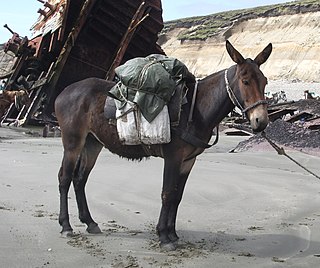
In biology, a hybrid is the offspring resulting from combining the qualities of two organisms of different breeds, varieties, species or genera through sexual reproduction. Hybrids are not always intermediates between their parents, but can show hybrid vigour, sometimes growing larger or taller than either parent. The concept of a hybrid is interpreted differently in animal and plant breeding, where there is interest in the individual parentage. In genetics, attention is focused on the numbers of chromosomes. In taxonomy, a key question is how closely related the parent species are.
Selfish genetic elements are genetic segments that can enhance their own transmission at the expense of other genes in the genome, even if this has no positive or a net negative effect on organismal fitness. Genomes have traditionally been viewed as cohesive units, with genes acting together to improve the fitness of the organism. However, when genes have some control over their own transmission, the rules can change, and so just like all social groups, genomes are vulnerable to selfish behaviour by their parts.

Drosophila melanogaster is a species of fly in the family Drosophilidae. The species is often referred to as the fruit fly, though its common name is more accurately the vinegar fly. Starting with Charles W. Woodworth's proposal of the use of this species as a model organism, D. melanogaster continues to be widely used for biological research in genetics, physiology, microbial pathogenesis, and life history evolution. As of 2017, six Nobel prizes had been awarded for research using Drosophila.

Haldane's rule is an observation about the early stage of speciation, formulated in 1922 by the British evolutionary biologist J.B.S. Haldane, that states that if in a species hybrid only one sex is inviable or sterile, that sex is more likely to be the heterogametic sex. The heterogametic sex is the one with two different sex chromosomes; in therian mammals, for example, this is the male.
Intragenomic conflict refers to the evolutionary phenomenon where genes have phenotypic effects that promote their own transmission in detriment of the transmission of other genes that reside in the same genome. The selfish gene theory postulates that natural selection will increase the frequency of those genes whose phenotypic effects cause their transmission to new organisms, and most genes achieve this by cooperating with other genes in the same genome to build an organism capable of reproducing and/or helping kin to reproduce. The assumption of the prevalence of intragenomic cooperation underlies the organism-centered concept of inclusive fitness. However, conflict among genes in the same genome may arise both in events related to reproduction and altruism.
Meiotic drive is a type of intragenomic conflict, whereby one or more loci within a genome will effect a manipulation of the meiotic process in such a way as to favor the transmission of one or more alleles over another, regardless of its phenotypic expression. More simply, meiotic drive is when one copy of a gene is passed on to offspring more than the expected 50% of the time. According to Buckler et al., "Meiotic drive is the subversion of meiosis so that particular genes are preferentially transmitted to the progeny. Meiotic drive generally causes the preferential segregation of small regions of the genome".
A sheep–goat hybrid is the offspring of a sheep and a goat. While sheep and goats seem similar and can be mated, they belong to different genera in the subfamily Caprinae of the family Bovidae. Sheep belong to the genus Ovis and have 54 chromosomes, while goats belong to the genus Capra and have 60 chromosomes. The offspring of a sheep-goat pairing is generally stillborn. Despite widespread shared pasturing of goats and sheep, hybrids are very rare, indicating the genetic distance between the two species. They are not to be confused with sheep–goat chimera, which are artificially created by combining the embryos of a goat and a sheep.
The mechanisms of reproductive isolation are a collection of evolutionary mechanisms, behaviors and physiological processes critical for speciation. They prevent members of different species from producing offspring, or ensure that any offspring are sterile. These barriers maintain the integrity of a species by reducing gene flow between related species.

Heterogametic sex refers to the sex of a species in which the sex chromosomes are not the same. For example, in humans, males, with an X and a Y sex chromosome, would be referred to as the heterogametic sex, and females having two X sex chromosomes would be referred to as the homogametic sex.
The concept of a biological species as a group of organisms capable of interbreeding to produce viable offspring dates back to at least the 18th century, although it is often associated today with Ernst Mayr. Species of the fruit-fly Drosophila are one of the most commonly used organisms in evolutionary research, and have been used to test many theories related to the evolution of species. The genus Drosophila comprises numerous species that have varying degrees of premating and postmating isolation between them. These species are useful for testing hypotheses of the reproductive mechanisms underlying speciation.
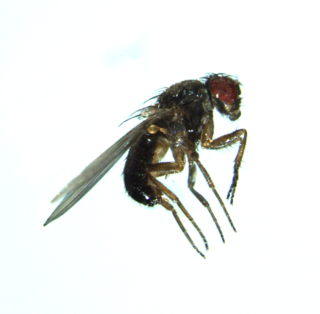
Drosophila pseudoobscura is a species of fruit fly, used extensively in lab studies of speciation. It is native to western North America.

Drosophila subobscura is a species of fruit fly in the family Drosophilidae. Originally found around the Mediterranean, it has spread to most of Europe and the Near East. It has been introduced into the west coasts of Canada, the United States, and Chile. Its closest relative is Drosophila madeirensis, found in the Madeira Islands, followed by D. guanche, found in the Canary Islands. These three species form the D. subobscura species subgroup. When they mate, males and females perform an elaborate courtship dance, in which the female can either turn away to end the mating ritual, or stick out her proboscis in response to the male's, allowing copulation to proceed. D. subobscura has been regarded as a model organism for its use in evolutionary-biological studies.
Hybrid incompatibility is a phenomenon in plants and animals, wherein most offspring produced by the mating of two different species are not viable or are unable to reproduce. Examples of hybrids include mules and ligers from the animal world, and subspecies of the Asian rice crop Oryza sativa from the plant world. Multiple models have been developed to explain this phenomenon. Recent research suggests that the source of this incompatibility is largely genetic, as combinations of genes and alleles prove lethal to the hybrid organism. Incompatibility is not solely influenced by genetics, however, and can be affected by environmental factors such as temperature. The genetic underpinnings of hybrid incompatibility may provide insight into factors responsible for evolutionary divergence between species.
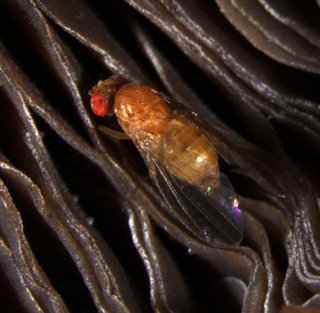
Drosophila neotestacea is a member of the testacea species group of Drosophila. Testacea species are specialist fruit flies that breed on the fruiting bodies of mushrooms. These flies will choose to breed on psychoactive mushrooms such as the Fly Agaric Amanita muscaria. Drosophila neotestacea can be found in temperate regions of North America, ranging from the north eastern United States to western Canada.

Drosophila testacea is a member of the testacea species group of Drosophila. Testacea species are specialist fruit flies that breed on the fruiting bodies of mushrooms. Drosophila testacea can be found in temperate regions of Europe, extending to east Asia. Drosophila testacea and Drosophila orientacea can produce viable hybrids, though they are separated by geography and behavioural barriers. Drosophila testacea females will also readily mate with Drosophila neotestacea males, but viable hybrids are never produced. This hybrid inviability ) may be due to selfish X chromosomes and co-evolved suppressors. Alternately, differences in sex pheromone reception could underlie female readiness and male willingness to copulate.
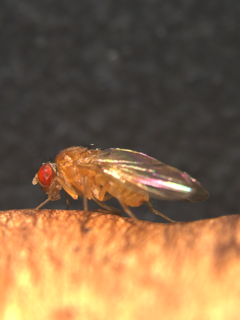
The Drosophila testacea species group belongs to the Immigrans-tripunctata radiation of the subgenus Drosophila, and contains 4 species: Drosophila putrida, Drosophila neotestacea, Drosophila testacea, and Drosophila orientacea. Testacea species are specialist mushroom-feeding flies, and can metabolize toxic compounds in Amanita mushrooms. The Testacea species group is studied for its specialist ecology, population genetics, and bacterial endosymbionts. The North American species Drosophila neotestacea is perhaps the best-studied of the group for its interactions with parasitic wasps and nematodes, bacterial endosymbionts, and trypanosomatid parasites. Of note, selfish X chromosomes have been discovered in three of the four Testacea group species.

The Drosophila quinaria species group is a speciose lineage of mushroom-feeding flies studied for their specialist ecology, their parasites, population genetics, and the evolution of immune systems. Quinaria species are part of the Drosophila subgenus.
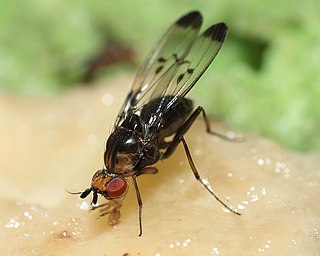
Drosophila silvestris is a large species of fly in the family Drosophilidae that are primarily black with yellow spots. As a rare species of fruit fly endemic to Hawaii, the fly often experiences reproductive isolation. Despite barriers in nature, D. silvestris is able to breed with D. heteroneura to create hybrid flies in the laboratory.










